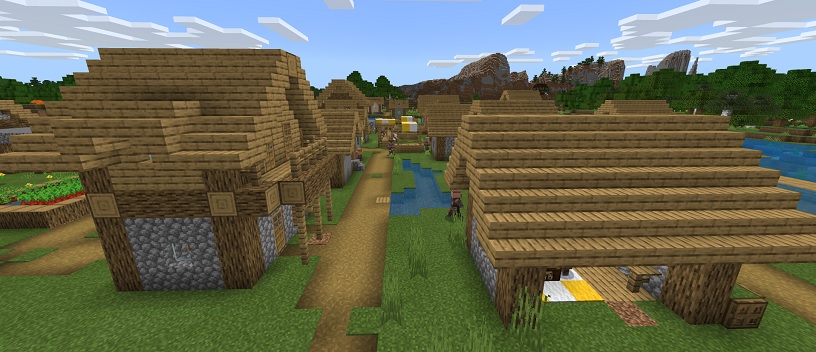Our Minecraft: Villager Breeding Guide features a look at how to breed villagers to increase the population of your nearby villages! We're going through all of the breeding requirements you'll need to follow, and will walk you through some of the new requirements in the 1.14 update. This guide has been updated to work with the most current 1.16.4 Minecraft release.
Maybe you’ve caused one too many problems with the local village, and negative gossip is spreading about you. Maybe you’ve built a massive metropolis in single-player mode, but it just feels too empty. Maybe you’re a seasoned Minecraft veteran coming back to explore Minecraft Version 1.14, and things aren’t working the way you expect. Perhaps you have dreams of a more Orwellian nature. No matter how you got here, what you want is lots and lots of villagers. Don’t worry, we won’t ask any tough questions. In this guide, you’ll find everything you need to know about breeding villagers, including how it’s been changed in Version 1.14 and the following pre-releases. For just that part, you can skip to the “Changes in 1.14” section down below. If you’re new to breeding villagers, read on!
Finding Villagers

The easiest way to find a villager is to look for a village! These collections of buildings appear scattered throughout the world, and will look different depending on the local climate. Be cautious when approaching a new location. The Village and Pillage update has added some new inhabitants to the Minecraft overworld, and many of them won’t be happy to see you. These unhappy villagers include:
- Zombie Villagers
- Pillagers
- Vindicators
- Evokers
- Illusioners
In every village, you can find blocks like the Fletching Table, the Lectern, the Barrel, and more that act as “job sites” for villagers. Any nearby villager can claim one of these job sites and start offering relevant trades to the player. For example, the Lectern is the job site for the Librarian, who will buy paper from you if you talk to them. There’s a lot to learn when it comes to trading with villagers, but to get started just talk to each villager and see what kind of trades they can offer.
The Basics
When you first get to a village, you may already see some big-headed babies running around! Baby villagers take 20 real-world minutes to grow up, and once they’re fully grown they’ll latch onto any unattended job site and start offering trades. Unlike other mobs in Minecraft, villagers can’t be bred on command just by feeding them a specific item. Instead, they plan out their families, deciding to breed on their own if the two main requirements are met.
First, both parents need to have a nice meal! Villagers actually have 8 hidden inventory slots (for a total of 12 slots) where they can store food and seeds, and each parent will need to fill up one of those slots with one of the following:
- 3 loaves of bread
- 12 carrots
- 12 potatoes
- 12 beetroots
In total, Villagers must hold 12 individual slots of food. Potatoes, carrots, and beetroots each account for 1 individual slot, which is why you need 12 of those vegetables in total. Loaves of bread, however, account for 4 slots per loaf, which is why you only need 3 loaves of bread in total.
Villagers will share food with each other when they have extra, and you can help out by throwing food to hungry villagers. Once two villagers are ready to breed, they will wait until the evening of that day and then, if all requirements are met, consume the required food in the process, quickly popping out a new baby villager. This part is similar to previous versions of Minecraft. However, the other requirement for breeding has undergone more extensive changes.
Changes in 1.14

The biggest change from previous versions is that villagers now determine their willingness to breed based on the number of nearby beds, rather than the number of nearby doors. Previously, the strategy for turning villages into cities was to pack tiny rooms in like sardines, with a wooden door for each resident. Now the villagers have developed some standards of living. In order for two villagers to have a child, there must be a bed for each of them to sleep in, plus one for the child. This means that big rooms with lots of beds and a steady food source are the new magic formula for pumping out villager babies.
The rooms must be big enough that the beds have at least two empty blocks of space above them. This will give room for the new baby villager to jump on the bed. Remember: you need three beds lined next to each other in total to breed the child.
Exceeding the Limits
The biggest issue with breeding villagers is that any village will eventually stop growing once there are no more unoccupied beds available for a new baby. This issue can be best solved by sending the newborn villagers a long distance away from their original bed. You could use an automatic minecart system or waterway for this, and before you say it would be too cruel to do so, rest assured that the little ones will forget all about their old village less than 10 seconds after they get 36 blocks away. This will both solve your overpopulation issue and provide a convenient way to transport villagers to their new homes. To keep your villager factory running at full capacity, consider using dispensers or an automatic harvester to keep a steady supply of food items available.
That's about it! To get your adult villagers happily employed in their new city, simply build them a bed and a job site and they will get right to work offering trades!
See Minecraft Toys & Collectibles on AmazonncG1vNJzZmiooqS0ornEoKyinJWoe6S7zGikoqaVmL%2BistNopKKmlZi%2ForLTZq2ipJyWtKa%2BjJupnp2UnruoecauoJ2dXw%3D%3D